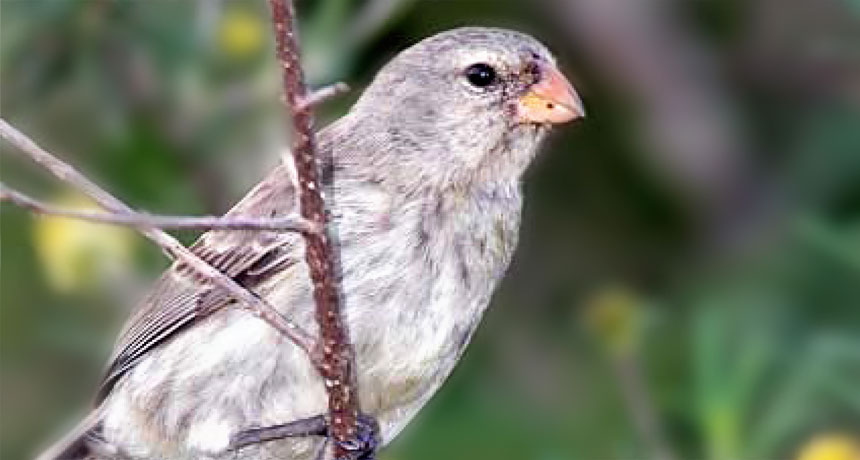
TELL DARWIN Crossing species lines and mating with the small tree finch (yearling shown) may be the undoing of a second species of Darwin’s finches in the Galápagos Islands.
Frank Sulloway
The lure of little guys of the wrong species — plus an invasion of flies — may drive one of Darwin’s finch species toward extinction.
Diverse finches that Darwin saw scattered across the Galápagos Islands have become favorite subjects for studying how species diverge or blur together in time frames a person can observe.
Now, on the island of Floreana, females of the medium tree finch (Camarhynchus pauper) are blurring species lines by crossbreeding with males of a smaller finch species (C. parvulus), says Sonia Kleindorfer of Flinders University in Adelaide, Australia. Just why isn’t clear yet. But recent invasion by flies with blood-sucking larvae and the relative rarity of medium finches may play roles, Kleindorfer and her colleagues report in the March American Naturalist.
If the medium tree finches keep jumping the species border, their kind may eventually go extinct on Floreana, the one island where it lives, and perhaps something new will emerge from the crossbreeding.
“This is essentially species extinction through evolution,” says integrative biologist Ole Seehausen of Eawag, the Swiss Federal Institute of Aquatic Science and Technology, in Kastanienbaum.
Human changes to landscapes, such as the introduction of invasive species, often fuel this kind of extinction because people can smooth away quirks of habitats that keep species separate in the same space. Yet, he says, “conservation biology has not really started taking this problem very seriously.”
The invasive fly Philornis downsi had spread to the Galápagos by the 1960s. Adult flies wouldn’t hurt a bird, but the larvae crawl into nasal passages as well as other internal and external sites of finch chicks and suck their blood. Nestlings that survive can grow up with deformed airways.
Medium tree finches are prone to extremely intense parasite infestations, Kleindorfer says.
In 2005, about 19 percent of the small and medium finches were hybrids, the researchers found. By 2010, the other year the researchers analyzed, crossbreeding reached 41 percent.
Kleindorfer doesn’t know yet why such a large portion of medium females mate with another species. Perhaps males of the smaller species have escaped the worst parasite-caused airway deformation and sing more compellingly than their medium counterparts. Biologists also predict that rare species, such as the medium tree finch, are likely to hybridize with a common one, such as the small tree finch.
Other Darwin’s finches hybridize, such as the Geospiza species on Daphne Major that Rosemary and Peter Grant of Princeton have tracked for nearly 40 years. There, a natural change in food supply increased birds’ tendencies to hybridize, says Peter Grant. On Floreana, people have degraded habitats for more than 150 years, so he wonders if dwindling finch food might have made medium finches increasingly rare and thus more likely to hybridize.






